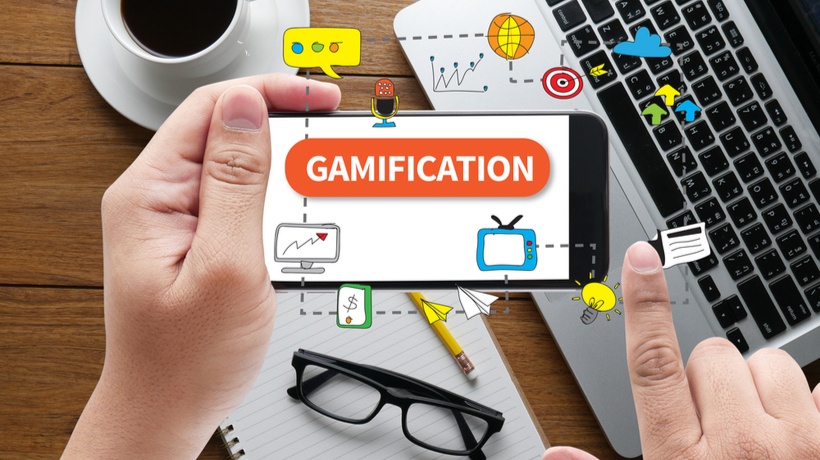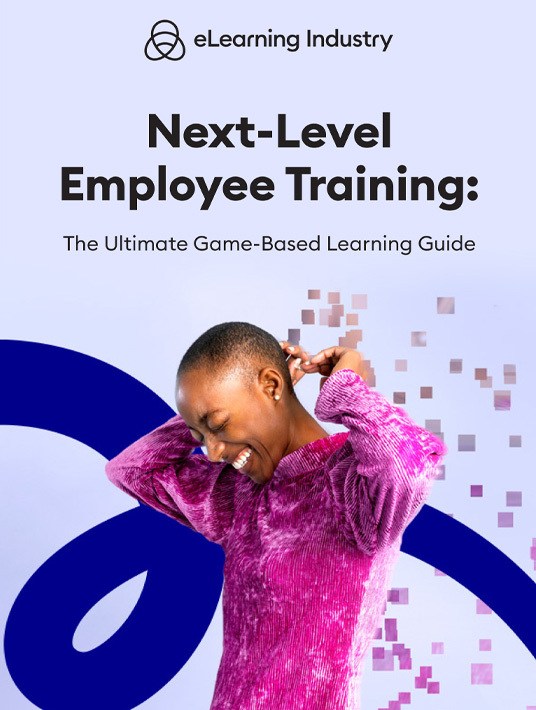
How Game-Based Learning And Training Gamification Differ
While one incorporates levels, badges, and other game mechanics into your current strategy, the other takes a more isolationist approach. The key to finding the best option for your next course design is to know how they contrast and compare. Gamification is more holistic. Incentives fuel learner motivation and track their progress. On the other hand, game-based learning utilizes games to reinforce knowledge, build skills, and test learner proficiency. Even if you plan to use both teaching techniques, it’s best to know where one ends and the other begins. Here are 6 quintessential distinctions between game-based learning and gamification training.

eBook Release
Next-Level Employee Training: The Ultimate Game-Based Learning Guide
This guide covers all of the game-based learning essentials to enhance your employee training program!
6 Differences Between Game-Based Learning And Training Gamification
1. Gamification Takes A Holistic Approach
Gamification involves game mechanics, rewards, and design elements that you would typically see in an online gaming experience. These components are incorporated into a “traditional” eLearning course to improve motivation and allow autonomous progress tracking. For instance, learners earn a badge for completing the activity or receiving high marks on an exam. On the other hand, game-based learning takes a more focused approach. As an example, add serious games to your existing strategy to reinforce compliance knowledge.
2. Game-Based Learning Centers On A Specific Skill Or Behavior
GBL has a narrower scope, in that games center on specific skills, performance issues, behaviors, or training topics. For example, customer service staffers must build their communication skills to enhance on-the-job performance. Serious games are used to identify mistakes or gaps so that employees can address them immediately. They’re also typically bite-sized, which makes them ideal JIT support tools.
3. Gamification Does Not Include Traditional Gameplay
One of the most popular myths regarding gamification is that it’s rooted in standalone games. Gamification training might include levels, points, and leaderboards. However, it does not follow a traditional gameplay format or structure. The primary focus is to improve work habits or broaden their knowledge. Gamification elements are merely there to support these outcomes. For instance, learners must participate in the course to achieve each milestone and assimilate the information. The point system allows them to monitor their training performance and see how far they’ve come.
4. Game-Based Learning Transforms Objectives Into Serious Games
Successful game-based learning begins with objectives and outcomes that serve as the foundation of your serious game design. Every gaming experience zeros in on talents, pain points, and obstacles that employees must focus on to achieve the best outcomes. Yes, gamification also requires clear objectives and goals. But GBL tackles every milestone with a targeted game instead of covering multiple topics simultaneously, as is the case with a comprehensive gamification strategy.
5. Gamification Relies On Rewards
This is where the line between training gamification and game-based learning gets a bit blurry. Gamification hinges on a solid reward system. Employees should be intrinsically motivated to achieve the goals, but badges or points give them a nudge. Game-based learning can involve incentives, as well. However, it’s more about the experience itself—the idea of progressing through levels and picking up info along the way or answering questions correctly to achieve the highest score.
6. Game-Based Learning Involves Experiential Feedback
While gamification uses rewards to provide feedback, game-based learning involves mistake-driven learning and experiential feedback. For example, a gamification course gives learners the opportunity to earn points for achieving the best branching scenario outcome or passing the final compliance exam. Receiving the minimum amount of points or none at all helps them highlight areas for improvement. Conversely, game-based learning allows learners to benefit from firsthand experience and real-world application. They can immediately see where they went wrong by the character’s reaction or the final outcome.
Both Approaches Center On Learner Motivation And Engagement
One thing that both GBL and gamification design have in common is that they get learners actively involved in their own development. Gamifying online training incentivizes the process. GBL gives learners an immersive and engaging JIT tool to address gaps on their own. Here are tips to combine this dynamic duo in your employee training strategy:
- Determine which objectives and outcomes are best for serious games versus eLearning gamification. Not all subject matter is suitable for microlearning games. For example, some compliance topics may require a full-length gamification course that covers all the key takeaways. Know the limitations and pros/cons of both approaches to find the best application for each.
- Use GBL to reinforce your gamification course and improve knowledge retention. For instance, add serious games to test employee proficiency and help them understand a more challenging sub-topic. They can also earn rewards for outperforming their peers during the game. Maybe even move up a spot on the leaderboard.
- Identify learner preferences before implementing your gamification strategy. Which games do they like? What is their main source of motivation? How can you improve engagement without making anyone feel singled out? For example, introverts might shy away from peer-based competition. Know your audience so that you’re able to find incentives and game mechanics that align with their needs and expectations.
Conclusion
Game-based learning and training gamification are two unique but complementary approaches. GBL centers on serious games to fill gaps and refresh learners’ memory. Gamification is all about embedding game mechanics and rewards into your course design. Which is best for your employee development program? The solution is often a hybrid strategy that blends gaming experiences with badges, boards, and points to maintain motivation. Survey your learners to find out what they need and choose the best incentives. Then develop a curriculum that considers their personality traits, goals, and personal preferences.
Invest in an eLearning content provider who can help you implement game-based learning and gamification in online training. Our online directory has outsourcing partners that specialize in gamification design for businesses big and small. Filter results by industry, solutions, and other essential criteria to quickly identify your top choices.
Download our eBook Next-Level Employee Training: The Ultimate Game-Based Learning Guide to target specific goals, challenges, and key takeaways with a GBL strategy.
